Talley is an unspoilt Village, which sits in the Towy Valley, north of Llandeilo. It is an ancient place, with the ruins of the old Twelfth Century Abbey dominating the centre of the Village, within a stones throw of the lake. The Village holds an interest to me because it is to Talley that my Mothers family came to live before the Great War. My Great Grandfather Albert Dexter was the Gamekeeper on the Edwinsford Estate, and is buried at the Churchyard in Talley. The War Memorial to the men of Talley who lost their lives during the Great War stands at the entrance to the ancient St. Michael’s Church, and takes the form of a simple granite cross, mounted on an octagonal plinth, bearing the names of the fallen.
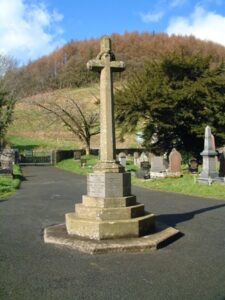
The Great War, 1914-1918
Oliver Boston, Private, 12471, Gloucestershire Regiment. Oliver was born in Ringsbury, Warwickshire, the son of Joseph and Ellen Boston. He had moved to Talley prior to 1911, and worked as a farm labourer at Glanyrafonddu Uchaf. Oliver enlisted into the 10th Battalion, Gloucester Regiment, which was attached to 1 Brigade, 1st Division. This Division had fought on the Western Front since the outbreak of war, and had taken part in the retreat from Mons to the Marne. It then moved to Ypres, and took part in the defence of the ancient city, during the First and Second Battles of Ypres. From 25 September 1915, the Division were at Loos, and it was during the Battle of Loos that Oliver was wounded. He was brought to the Hospital at Bethune, where he died of wounds on 9 October 1915, aged 23. He is buried at Bethune Town Cemetery, France.
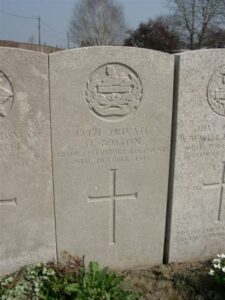
Ebenezer Davies, Private, 45200, Welsh Regiment. Ebenezer was the son of Thomas and Elizabeth Davies, of Cross Inn Cottage, Talley. He enlisted into the army, and was posted to France during the summer of 1916, joining the 15th Battalion, Welsh Regiment, which was known as the Carmarthen Pals battalion. The battalion had been in France since December 1915 attached to 114 Brigade, 38th Welsh Division, and famously captured Mametz Wood during July 1916, suffering heavy losses in the process. Ebenezer was probably one of several hundred reinforcements to the battalion before it moved with the rest of the 38th Division to positions at Boesinghe, north of Ypres. Ebenezer was wounded while the 15th Welsh were in the line during February 1917, and died of his wounds on 20 February 1917, aged 38. He is buried at Mendinghem Military Cemetery, Belgium.
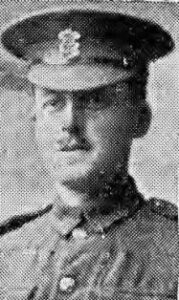
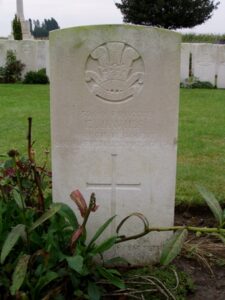
John Norman Davies, Private, 29623, Manchester Regiment. John was the son of Enoch and Margaret Davies, of 98, Alexandra Road, Moss Side, Manchester. His parents were from Talley, and John spent much of his childhood visiting his grandmother Elizabeth at Glandwr. He enlisted in Manchester on 16 June 1916 into the 26th Battalion, Manchester Regiment, and was posted to France on 14 December 1916, joining the 16th Battalion, Manchester Regiment, which was attached to 90 Brigade, 30th Division. In March 1917 the Division followed the German Retreat to the Hindenburg Line, and in April took part in the First and Second Battles of the Scarpe. Later that year the division moved north to Ypres, and fought at the Battle of Pilckem. John was mortally wounded during the opening assault on 31 July 1917, and died that same day, aged 24. He is buried in Bedford House Cemetery, Belgium. John is not commemorated on the Talley memorial, but on his grandmothers grave in the churchyard.
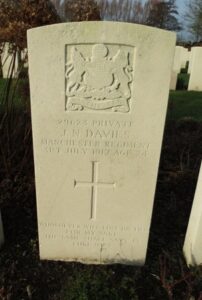
John Talley Evans, Lance Sergeant, 29508, Royal Welsh Fusiliers. John was the son of John and Elizabeth Evans, of Halfway, Talley. John enlisted at Cardiff on 8 December 1915 into the Royal Welsh Fusiliers, and was posted to North Wales. On 5 July 1916 he was posted to France, joining the 2nd Battalion, Royal Welsh Fusiliers. The Battalion formed part of 19 Brigade, 33rd Division, and was famous as being the Battalion in which Frank Richards, Siegfried Sassoon and Robert Graves. The battalion saw heavy fighting throughout the Somme offensive. John was mortally wounded on 7 November 1916, and died that same day, aged 23. John was buried near the dressing station where he died, but his grave was lost during further fighting in the area, and he is now commemorated on the Thiepval Memorial, France. His brother Thomas also fell.

Thomas Evans, Gunner, 228095, Royal Field Artillery. Thomas was the son of John and Elizabeth Evans of Halfway, Talley. He enlisted in Glasgow into the Royal Field Artillery, and was posted to France, joining B Battery, 330th Brigade, which formed part of the 66th (East Lancs.) Division. The division was caught up in the German Spring offensive of 21 March 1918 and saw heavy fighting during the subsequent retreat. Thomas was wounded and taken prisoner during this turbulent time, and died of his wounds whilst a POW on 28 April 1918, aged 29. He is buried in Roisel Communal Cemetery Extension, France. His brother John Talley Evans also fell.

Thomas Evans, Lance Corporal, 17757, Royal Welsh Fusiliers. Tom was the son of Thomas and Jane Evans, of Cwmryn, Talley. He worked at Neath prior to the war, and married Margaret Hannah Wilcox on 12 September 1903. Thomas enlisted at Neath into the 1st Battalion, Royal Welsh Fusiliers, which was attached to 22 Brigade, 7th Division. The Division was a Regular Army Division which landed in Zeebrugge on 6 September 1914. Regarded as one of the best British Divisions of the war, it fought at First Ypres, Neuve Chapelle, Aubers, Festubert, Givenchy and Loos, before moving south, to take part in the opening actions of the Battle of the Somme. At the Somme, the Division was stationed in the Fricourt area, moving forward and capturing the village of Mametz. It was during this opening stage of the battle that Thomas was wounded. He was brought back by rail to the Base Hospital at Boulogne, where he died of wounds on 9 July 1916, aged 38. He is buried at Boulogne Eastern Cemetery, France. Thomas is not commemorated locally.
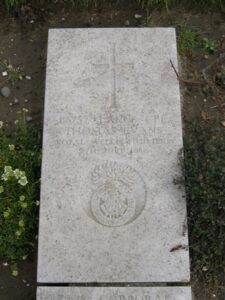
William Evans, Corporal, 290285, Royal Welsh Fusiliers. William was born in 1889 in Pencraig, Talley, the son of James Evans. He was raised in a home before finding work at Llandinam some years before the war. William lived as a married man with Nancy Irene Gentle, and their daughter Kathleen was born at Llandinam on 24 November 1914. William enlisted into the 7th Battalion, Royal Welsh Fusiliers at Newtown on 27 August 1914. The battalion was a Territorial unit, which mobilised for war at Newtown in August 1914, as part of North Wales Brigade, Welsh Division and moved to Conway until the end of the month, before moving to Northampton. In December the Division moved to Cambridge and then in May 1915 to Bedford, where the Division was numbered and the formation became 158 Brigade, 53rd (Welsh) Division. On 19 July 1915 the entire Division sailed from Devonport for Imbros and on 9 August 1915 landed at Suvla Bay. The infantry moved off the beaches into the bush, but due to a lack of maps and no knowledge of the terrain, many of the units became disorientated, and the situation became chaotic. The Division was eventually evacuated from Gallipoli in December 1915, moving to Egypt to join the EEF, and helped guard the Suez Canal before taking part in operations to drive the Turks out of the Sinai. The EEF then turned its attention onto driving the Turks out of Palestine, and on 26 March 1917 launched its first offensive against the coastal city of Gaza, which guarded the road to Jerusalem. Initial gains during the day were lost when the assaulting divisions lost touch with each other, and communication broke down when a thick fog cloaked the battlefield. William was posted as missing, believed killed in action during the fighting that day. The 27-year-old has no known grave and is commemorated on the Jerusalem Memorial, Israel. His partner Nellie, later moved to 8, Frolic Street, Newtown with their daughter Kathleen, before emigrating to Canada. She married Harold Harry, and the couple returned to Newtown, where Nellie died in 1986.
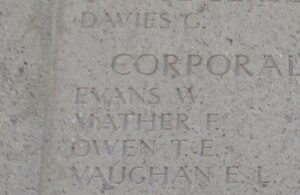
William Edward Evans, Private, 19570, Royal Fusiliers. William was born on 16 April 1880, the son of Dafydd and Jane Hancock Evans, of Ty Ann Arthur, Talley. He worked for the GWR prior to the war and enlisted at Ammanford into the army. William joined the 26th Battalion, Royal Fusiliers, which was known as the Bankers Battalion, and landed in France on 4 May 1916 attached to 124 Brigade, 41st Division. The Division moved to the Somme, and took part in the Battle of Flers, and the later fighting around Courcelette. William was killed in action near Courcelette on 10 October 1916, aged 36. He is remembered on the Thiepval Memorial, France.
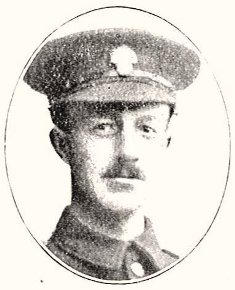
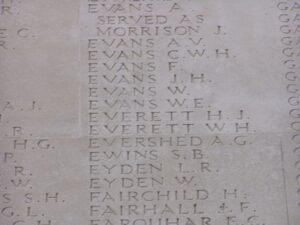
Wymond Howard Lloyd, Second Lieutenant, Herefordshire Regiment. Wymond was born on 20 March 1883, the eldest son of Howard Meuric Lloyd and Aimee Lloyd (nee Peel) of Delfryn, Talley. Wymond was educated at Malvern and New College, Oxford, where he had completed two years’ residence, and was half way through his degree and studying for the Civil Service. He rowed for his college in the second eight, and was a member of the O.U.O.T.C., and so was commissioned into the Herefordshire Regiment as a Second Lieutenant in September 1914. Wymond embarked with his regiment to Gallipoli in August, 1915, and was five weeks at Suvla before contracting enteric fever and dysentery, which required his return home after many weeks in hospital. Upon his return, he was posted to Park Hall Camp, Oswestry, engaged on light duty and hoped to pass for active service at a medical board on 23 March, but on 18 March he was struck by a train while walking near the camp, and brought to Oswestry Cottage Hospital, where he died the following day, on 19 March 1916. He was 22 years of age, and was brought home to be buried with military honours in Llangadock Cemetery, on 23 March 1916. The Colonel commanding the Welsh Division Grouped Depots, T.F., wrote:- “Your son was a very fine young officer, and had gained the love and respect of all who came into contact with him, both in Gallipoli and here. I regret his loss personally, for I know what good work he was doing here in the training of the men.”
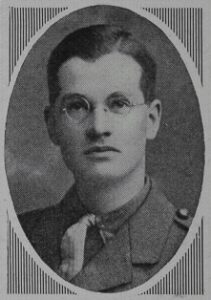
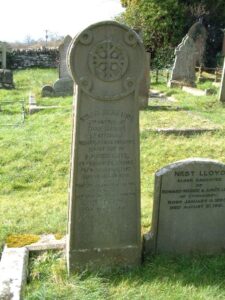
Cecil Evelyn Long-Price, Captain, West Yorkshire Regiment. Cecil was born on 23 February 1878, the son of David Long Price and Suzanne Price, Talley House, Talley. He had originally been commissioned into the Munster Fusiliers, before being posted to the Indian Army in 1900. He married Mary Langford Sainsbury at Taunton on 1 January 1913. At the outbreak of the Great War, Cecil was transferred from the West African Regiment to the 9th Battalion, West Yorkshire Regiment, which was attached to 32 Brigade, 11th (Northern) Division. The Division were sent to Gallipoli, and landed at Suvla Bay on 7 August 1915. Cecil was 38 years old when he was killed in action that same day. He is remembered on the Helles Memorial, Gallipoli.
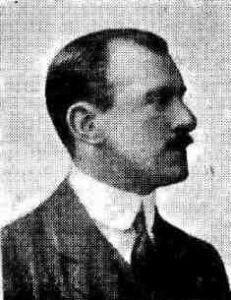
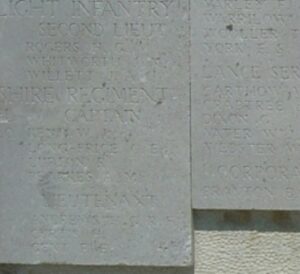
James Arthur Parry, Private, 29429, South Wales Borderers. James was the son of John and Gwenllian Parry, of Esgairwen, Cwmdu. James enlisted at Ammanford into the 2nd Battalion, South Wales Borderers, and probably joined the battalion after its withdrawal from Gallipoli. In May 1916 the battalion moved to France, with 87 Brigade, 29th Division. The Division moved to positions at Beaumont Hamel, and attacked there on 1 July 1916, suffering heavy casualties. The following year they took part in the Third Battle of Ypres, before moving to Cambrai. The Division took part in the Battle of Cambrai, where the use of massed tank formations was pioneered. James was killed in action there, aged 20, on 3 December 1917, and is remembered on the Cambrai Memorial, Louverval, France. His brother Thomas also fell.
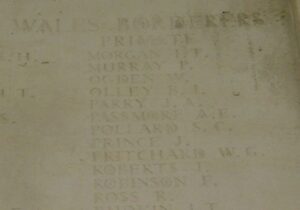
Thomas Peter Parry, Private, 4197, Welsh Regiment. Thomas was the son of John and Gwenllian Parry, of Esgairwen, Cwmdu. Thomas enlisted at Ammanford into the 1/4th Battalion, Welsh Regiment, which was attached to 159 Brigade, 53rd (Welsh) Division. The Division was sent to the Mediterranean, and on 8 August 1915 landed at Gallipoli, where it was immediately thrown into action. It was here, during the Battle of Sari Bair, that Thomas was killed in action on 11 August 1915, aged 30. He is remembered on the Helles Memorial, Gallipoli. His brother James also fell.
John Archibald Thomas, Private, Glamorgan Yeomanry. John was born in 1897, the son of John and Frances Elizabeth Thomas, of Edwinsford Forge, Talley. He had emigrated to Australia during 1908, where he worked as a farmer, but had returned home to visit his family in May 1914. The outbreak of war meant that John couldn’t return to Australia, so he enlisted into the Glamorgan Yeomanry. He survived the war, probably taking part in the Palestinian campaign with the 24th Welsh, before being demobilised, and set up home temporarily at 2, Claremont Villas, Carmarthen, while he awaited a chance to return to Australia. John had suffered from depression since leaving the army, and was said to be worried about being able to return to Australia. He was discovered dead at Capel Evan, near Wellfield Road, Carmarthen on Monday 22 September 1919, and an autopsy showed that he had killed himself by cutting his own throat with a razor. John was 30 years old, and was buried at Carmarthen. No more is presently known of him, and he is not commemorated on any war memorial, even though his depression was brought on by his service.
Joshua Williams, Private, 633812, London Regiment. Joshua was born at Llansadwrn in November 1886, the son of William and Eliza Williams. He worked as a Draper, residing at Ty Coch, White Square, Taliaris. Joshua enlisted on 18 November 1915 into the 15th Battalion, London Regiment, and on 5 July 1916, he embarked with the Battalion for France, where he transferred to the 20th Battalion, London Regiment, attached to 141 Brigade, 47th (London) Division. The Division fought on the Somme that year, through the Battles of Flers-Courcelette and Le Transloy, where they captured Eaucourt L’Abbe, and attacked the Butte de Warlencourt. Joshua took ill after these actions, and was admitted to the 2nd Australian General Hospital at Boulogne with influenza. On 2 November 1916 he returned to England, and spent the next few months at the 2nd General Eastern Hospital, Brighton. Joshua was discharged from the army on 26 June 1917, owing to ill health, and was transferred to Beechwood House Hospital, Newport, where he sadly died on 17 September 1917, suffering from Cardiac Failure. He is buried at Taliaris (Holy Trinity) Churchyard. Joshua was accepted for commemoration by the CWGC on 27 May 2011 after his case was put forward to the CWGC by Dave Hanson.
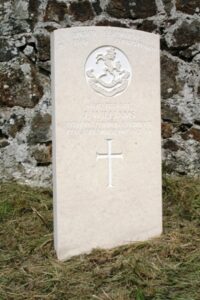
Evan George Wright, Private, 5136, Welsh Regiment. Evan was born in 1896, the son of Alfred John and Emily Jane Wright, of Maesyrhiw, Talley. Evan enlisted at Carmarthen into the 1/4th Battalion, Welsh Regiment, which was attached to 159 Brigade, 53rd (Welsh) Division, and sailed for the Mediterranean. The Division landed at Gallipoli on 8 August 1915, and was immediately plunged into heavy fighting. It was at Gallipoli, during the Attack on Scimitar Hill, that Evan was killed in action on 10 August 1915, aged 19. He is remembered on the Helles Memorial, Gallipoli.
World War Two, 1939-1945
David Evans, Civilian. David was the son of David and Anne Evans, of Glanyrafonddu Isaf, Talley, and had worked as a rural postman. He had moved to Government Buildings, 10, St. Mary Square, Swansea with his wife Dinah, to work in Swansea Docks. He was killed during an air raid on Swansea, while working at the Mole, in King’s Dock, Swansea harbour on 10 July 1940, aged 52. David is buried in Talley Churchyard. He is not commemorated on the Talley war memorial.
Wilfred John Rawlins, Private, 11266619, East Yorkshire Regiment. Wilfred was born at Abergele in 1922, the son of Ernest William Rawlins, and of Alice Maud Rawlins (nee Dexter). His mother’s parents lived on the Edwinsford Estate at Talley, where her father, Albert Dexter, was gamekeeper, and Wilfred spent much of his childhood in the village. He served with the 2nd Battalion, East Yorkshire Regiment, which was a regular army battalion, attached to the 3rd Infantry Brigade. The battalion landed on Queen Red Beach, near Hermanville, Normandy on D-Day, 6 June 1944, and was tasked with the elimination of several German strong-points in the area. Wilfred was killed during heavy fighting during the night. He was 22 years old, and is buried in Hermanville War Cemetery, France. Wilfred is not commemorated on the Talley memorial, and does not appear to be commemorated anywhere else locally.
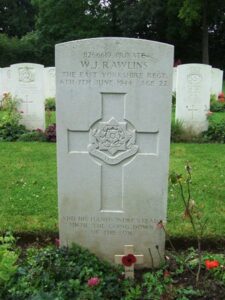
Edward Ronald Ellis Thomas, Sergeant, 1410623, Royal Air Force Volunteer Reserve. Edward was born on 16 January 1922, the son of David Ellis Thomas and Hilda Jane Thomas, of Southend, Mumbles. The family had moved to Talley prior to the war, and Edward volunteered to serve with the Royal Air Force. He was posted to Calcutta in 1942 with 215 Squadron, Royal Air Force, which was equipped with the Vickers Wellington. The squadron undertook bombing operations against the Japanese using the Vickers Wellington. On 8 August 1943, Edward was the navigator aboard Wellington HE126 which took off from Jessore to carry out an intruder patrol. The aircraft got into difficulties during takeoff, and crashed into trees, exploding upon impact and killing all of the crew of six men. Edward was just 21 years old when he died in the crash. He was initially buried in Jessore, India, but his grave was later relocated to Chittagong War Cemetery, Bangladesh. His brother, Edgar Sydney Thomas, had served with the Auxiliary Fire Service during the war and died on 19 November 1946, aged 35. He is buried in Talley Churchyard, and Edward is commemorated on his grave. Edward is not commemorated on the Talley war memorial.